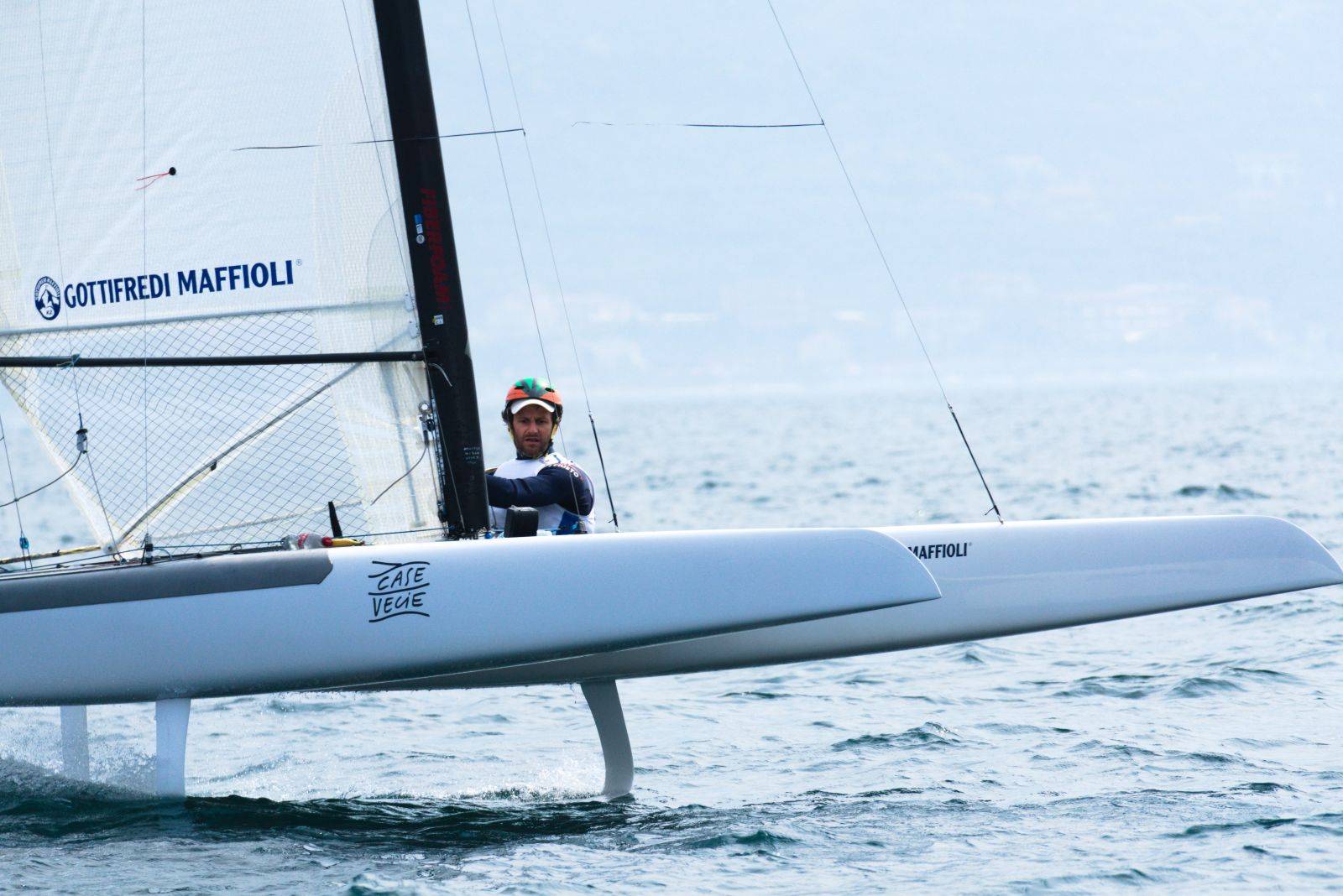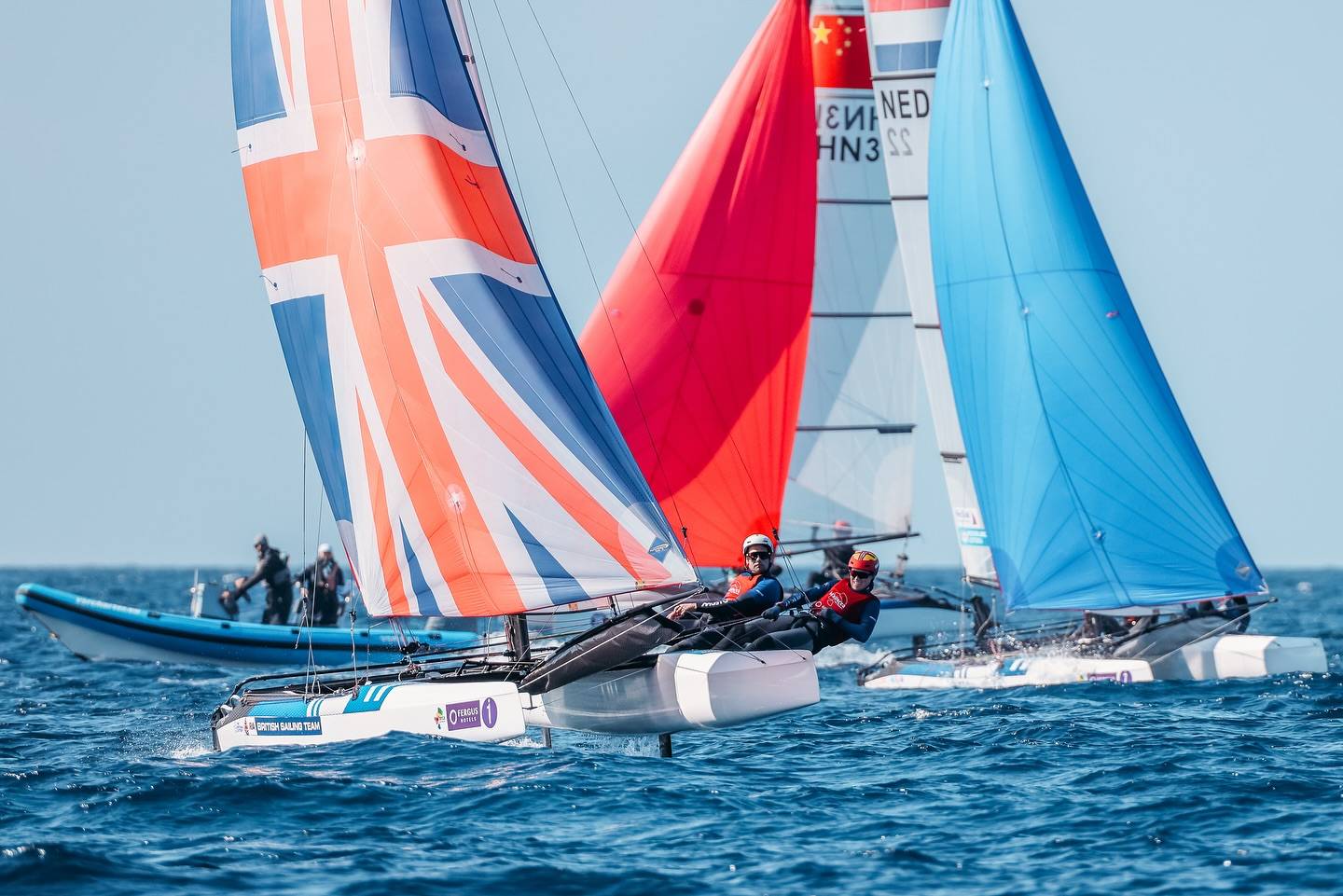G32 Flying 32 Cat Explained: Interview with Andrew MacPherson
One of the good things of editing CSN is being in touch with some of the very best new projects going on worldwide. And this is one of the most interesting along the Flying Phantom, both derived from Fischer’s Mayfly tests for a flying racing machine. Now with the Americas Cup going airborne, we will see further developments, but this is clearly a case of Trickle Up , from beachcats to Cup.
Andrew MacPherson has been lucky enough to be involved on the Nacra F20c, the Phantom F project and now along with Fischer and the GC32 management group embarking himself on the top production multihull you may find nowadays.
It will fly? Well he says it will, I posted today some low-flying pics of the Phantom, and although it failed at Aarhus I also posted some images of Fischer flying his prototype A-Class at Noumea.
As I said with the MayFly, need to be tested yet, but beyond that these new machines are clearly the ultimate weapon.
I can imagine how people saw in awe what the Wright brothers were doing at their bike shop, or how Herreshoff was being pointed in 1900s on his Amaryllis racing cat.
We are experiencing history in the making
——–—————-
– You’ve been telling me for a while now about this new 30 foot project, but it is a special project, different from the latest 30′ released in these past months, why the GC32 is so diff?
Andrew MacPherson: We were in the latter stages of planning an X40 campaign for 2012 and at the critical point we made the decision that the X40 was not really a solution for us, and after talking to some other owners they had the same feelings. So we began to look at options that were easier to manage and offered high quality racing. After spending some months to asses the options we came to the realisation that there was a big gap in the market place for a one design race boat in the 30-35ft range, it had to be capable of racing in all conditions and not be a “lake special” or an offshore tank.
A bit like the multihull version of a Melges 32 or Soto 40 that you guys have down there. But the actual boat is only part of the picture, we all want to race!!! A plan had to be created that included the best boat and series. It was pointless to do one without the other. We needed a sustainable solution so that owners could buy into the class and enjoy the racing without spending a fortune and also have an entry point that allowed teams including younger teams to get sponsors and enter the game. Now after a year of hard work we are very close to launching the first two boats and we also have 5 regattas in Europe scheduled for 2013 and interest from the USA and Australia for similar setups.
– But beyond the need for a boat of that size and a racing circuit, the boat also has some special features
Yes, we can clearly see that the days of the straight daggerboards are over! Once you have sailed with foils providing lift its very hard to go back to the old style. But a simple curved foil like you see on the A cat, Nacra F20 and 17 are not perfect solutions and are even less so on a larger boat. This is due to the difficulty in managing the lift from the foils and their angle of attack. On a small boat its easy to move your body weight on the trapeze in order to manage the foils behaviour, but on a larger boat, say 32ft its not possible to do this effectively and as such you end up with a less than optimal solution. The GC32 uses double “S” daggerboards and “L” rudders to manage the ride height issue and allow the boat to foil when sailing downwind and semi foil upwind in much the same way as we have seen the ETNZ AC72 doing.
 – This is the Flying conf Martin Fischer designed and implemented on his Acat?
– This is the Flying conf Martin Fischer designed and implemented on his Acat?
The Double “S” foil and “L” rudder layout is what Martin has been working on with his A cat and also we have it on the Flying Phantom. On a Larger scale there is an M2 (28ft) cat in Switzerland with the same configuration and all boats are performing exceptionally well.

– So Martin is the head designer for your project.
 Yes, we are very lucky to have Martin running the design side of the project. We also have Brett Ellis (ex Alinghi) doing the structural engineering, A great team at Southern Spars for the beams and mast, Heol Composites for the foils and Premier Composites for the hulls. Its been a privilege to work with the entire team.
Yes, we are very lucky to have Martin running the design side of the project. We also have Brett Ellis (ex Alinghi) doing the structural engineering, A great team at Southern Spars for the beams and mast, Heol Composites for the foils and Premier Composites for the hulls. Its been a privilege to work with the entire team.
– You said you have an M2 with this conf already, so beyond the new platform the concept is well proven? Or you’ll need to tweak further?

 The testing on the M2 has been really impressive, The modified boat has shown that there is no performance penalty in the light winds and has a clear advantage in hull flying conditions due to both the lift from the leeward foil, but also the increased righting moment generated by raking the windward foil to pull the windward hull down. On the Flying Phantom we have been really happy with the testing so far, but we had some issues with the rudder rake system which was taken directly from the A-class prototype and has proven to be a bit lightly built for the bigger boat. On the GC32 we have the same style rake adjustment as the M2 is running with great results.
The testing on the M2 has been really impressive, The modified boat has shown that there is no performance penalty in the light winds and has a clear advantage in hull flying conditions due to both the lift from the leeward foil, but also the increased righting moment generated by raking the windward foil to pull the windward hull down. On the Flying Phantom we have been really happy with the testing so far, but we had some issues with the rudder rake system which was taken directly from the A-class prototype and has proven to be a bit lightly built for the bigger boat. On the GC32 we have the same style rake adjustment as the M2 is running with great results.
– This can be an eye opener for many, as the ACup teams are spending millions on development on their cats to make them flying , and not that smooth in some cases, which is the price range you are targeting?
We are lucky that we dont have the rule about lifting the windward daggerboard within 30 seconds of a tack or gybe like the AC72 rules stipulate, The GC32 is free from this and as such we can use the best solution without the limits of rules.The price for a complete GC32 with sails is around 200k Euro Ex factory
– 200K? To compare Which is the price for an AC45 aprox and an X40?
Last time i checked, the X40 was 400k and the AC45 is about 800k. We worked very hard to develop an extremely high quality boat for a price that is great value.
– Yes, reviewing some other boat costs and the package you are delivering it seems a good price. How many crews on board?
With 4 crew it means everyone is busy but not overloaded. This allows the boats to be sailed by youth teams and owner drivers
– In an ideal world the AC72 would be using this?
The issue with allowing the AC72’s to use the windward foil is one of cost… The ability to increase righting moment with a foil means that you are much more powered up and you have to build your boat accordingly. So they tried to make a rule to stop this happening and by doing so they made the foiling equation a harder one to deal with.
– Which are the direct competitors or alternatives in the market for this new 32 foot? I’m seeing lots of 30′ projects, but none taking off, a formula should be created?
I think that there are many options for a 30 odd ft multihull, but there really are no direct competitiors to the GC32, besides the features of the boats the critical difference is that there is a race series in motion for the European summer of 2013 with the GC32.
– Ok, so you are launching 2 boats, and any others on queue?
Yes, we have more on order and we are working with our partners to ensure fast delivery
– You compared ETNZ foil system and you are saying as I did too, is the best solution so far. What do you think Oracle is going to do? they will stick with the L system?
That’s the million dollar question! I think the Oracle guys have the potential to make a very fast boat in that configuration, the real goal is to be fast consistently around the track and be able to handle less than ideal conditions. If they get that right then I think they can be very strong. The kiwi’s have shown a solution that appears to be reliable, versatile and pretty quick in isolation. When we see these boats on the same track is when we know for sure who has the right solution. Plus we have 2 more teams yet to reveal their solutions, Its very exciting times for high performance sailing!
For more info go to https://www.thegreatcup.com/
—ENDS—
Copyright Catsailingnews.com





























So if its a brand new one design wih no "rules" why don't you use trim tabs on the foils so it becomes controllable? Seems to me making foils with no way of trimming is a very difficult thing to do and very limiting. Regards Peter S
Are you kidding? Trim tabs? hahaaa
This is an auto regulated system patented by Fischer, no need for trim tabs.
Read the MayFly tehcnical paper and other posts here in csn.
Hi Peter,
trim tabs connected to a surface sensor could have been an option but we wanted to keep it relatively simple and robust. A 32ft catamaran develops much more power than a Moth and we were a bit afraid that the surface sensor wouldn't stay there very long in rough conditions. I think we should first test such an active control system on a smaller but nevertheless powerful boat, as for instance the Flying Phantom. Once that is done we may think of scaling it up to a bigger boat.
cheers
Martin Fischer